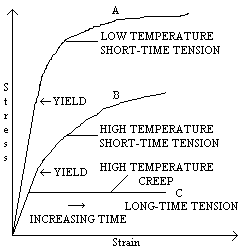Creep: A permanent strain that increases as a function of time under load and elevated temperature. A material can demonstrate myriad of stress-strain variations depending on the operating temperature.
 |
Case A: Material specimen is exposed to low temperature, then is put in the testing machine and pulled under increasing load and constant temperature. Case B: Material specimen is exposed to high temperature, then is put in the testing machine and pulled under increasing load and constant temperature. Case C: Material specimen is exposed to high temperature while in the testing machine and being pulled at a constant load level. Note: Cases A and B - Constant temperature and time but varying load. Case C - Constant temperature and load but varying time. |
The General Creep Pattern:
The general creep pattern can be seen using a plot of permanent strain versus time while holding the temperature and applied load fixed. The curve is divided into three segments indicating the three stages of creep that eventually lead to the rupture (failure) of the specimen.
|
Stage 1 : Initial creep stage includes elastic deformation, the rate of creep decreases with time. Stage 2 : Secondary creep stage at which the rate of creep is practically constant up to the transition point. The creep rate at this stage is the minimum. Stage 3 : Tertiary creep stage begins at the transition point and indicates the greatest creep rate that eventually leads to rupture in a relatively short time. |
 |
Age Creep Forming:
This is a process used for forming thick plates into a desired contoured shape. In aircraft industry, this process is used to give aluminum wing skin its airfoil shape. Following machining, the skin is placed over a mold and covered with a high-temperature plastic bag. It is then placed inside an oven (or autoclave) with the air inside the bag vaccumed out. Additional pressure can be exerted if placed inside an autoclave. After a period of about 24 hours the skin is removed from the oven and cooled to room temperature prior to use.